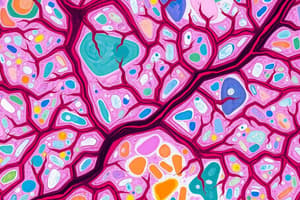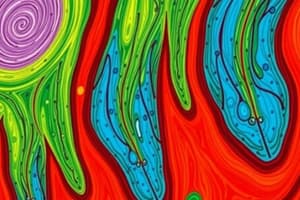Podcast
Questions and Answers
What is the primary force that draws water upwards in a plant?
What is the primary force that draws water upwards in a plant?
- Capillarity
- Transpiration pull (correct)
- Osmosis
- Root pressure
Which structure is primarily involved in the translocation of manufactured food in plants?
Which structure is primarily involved in the translocation of manufactured food in plants?
- Xylem
- Phloem (correct)
- Stomata
- Root hairs
How does water vapor loss from mesophyll cells affect water potential?
How does water vapor loss from mesophyll cells affect water potential?
- It decreases the water potential of the mesophyll cell walls. (correct)
- It increases the water potential of the mesophyll cells.
- It has no effect on water potential.
- It pulls water from the roots directly.
What effect do thorns and hairs on a leaf have on transpiration?
What effect do thorns and hairs on a leaf have on transpiration?
What term describes the loss of water vapor from the aerial parts of the plant?
What term describes the loss of water vapor from the aerial parts of the plant?
What structure do mesophyll cells utilize to diffuse water molecules into air spaces?
What structure do mesophyll cells utilize to diffuse water molecules into air spaces?
What effect does a lower surface area of leaves have on transpiration?
What effect does a lower surface area of leaves have on transpiration?
Which factor helps build tension and suction force at the top of the stem xylem?
Which factor helps build tension and suction force at the top of the stem xylem?
What type of neurons conduct nerve impulses from sensory organs to the central nervous system?
What type of neurons conduct nerve impulses from sensory organs to the central nervous system?
What role do the Casparian strips play in the endodermis?
What role do the Casparian strips play in the endodermis?
Which type of tissue is characterized by actively dividing cells that are not specialized?
Which type of tissue is characterized by actively dividing cells that are not specialized?
In the internal structure of a young dicotyledonous stem, which tissue is found between the xylem and phloem?
In the internal structure of a young dicotyledonous stem, which tissue is found between the xylem and phloem?
What is the primary function of interneurons in the nervous system?
What is the primary function of interneurons in the nervous system?
Which process primarily drives water movement from the root hair to the xylem?
Which process primarily drives water movement from the root hair to the xylem?
Where is the apical meristem primarily located in a plant?
Where is the apical meristem primarily located in a plant?
What component of the central cylinder contains xylem and phloem?
What component of the central cylinder contains xylem and phloem?
Which type of permanent tissue is responsible for the transport of nutrients and sugars in plants?
Which type of permanent tissue is responsible for the transport of nutrients and sugars in plants?
What role does the lateral meristem play in plant growth?
What role does the lateral meristem play in plant growth?
What happens to the vacuole of a root hair cell when water enters?
What happens to the vacuole of a root hair cell when water enters?
Which statement about nerve tissue is correct?
Which statement about nerve tissue is correct?
What is the primary component of the pith in the central region of a stem?
What is the primary component of the pith in the central region of a stem?
Which statement describes the flow of water through the roots?
Which statement describes the flow of water through the roots?
Which of the following is NOT a type of permanent tissue in plants?
Which of the following is NOT a type of permanent tissue in plants?
What is the water potential in the soil relative to the water potential in the root hair cell sap?
What is the water potential in the soil relative to the water potential in the root hair cell sap?
What is the primary function of collenchyma in plants?
What is the primary function of collenchyma in plants?
Which type of plant tissue is characterized by its thickened walls and the presence of lignin?
Which type of plant tissue is characterized by its thickened walls and the presence of lignin?
What is the primary function of phloem tissue in plants?
What is the primary function of phloem tissue in plants?
What feature of the epidermis helps to reduce moisture loss in leaves?
What feature of the epidermis helps to reduce moisture loss in leaves?
Which of the following tissues is made up of elongated cells without thickened walls?
Which of the following tissues is made up of elongated cells without thickened walls?
What is an organ in the context of plant structure?
What is an organ in the context of plant structure?
Which cells are primarily responsible for water transportation in plants?
Which cells are primarily responsible for water transportation in plants?
What type of structural support is provided by sclerenchyma tissue?
What type of structural support is provided by sclerenchyma tissue?
What distinguishes the structure of arteries from veins?
What distinguishes the structure of arteries from veins?
Which structure is responsible for preventing backflow of blood in veins?
Which structure is responsible for preventing backflow of blood in veins?
What are smaller veins called?
What are smaller veins called?
How do capillaries differ from arteries and veins?
How do capillaries differ from arteries and veins?
What role does the middle layer of smooth muscle in arteries serve?
What role does the middle layer of smooth muscle in arteries serve?
Which blood vessel type carries oxygenated blood away from the heart?
Which blood vessel type carries oxygenated blood away from the heart?
How does blood flow in veins compare to that in arteries?
How does blood flow in veins compare to that in arteries?
What is the function of the hepatic portal vein?
What is the function of the hepatic portal vein?
Flashcards are hidden until you start studying
Study Notes
Nervous Tissue
- Nerve tissue is found in the brain and the spinal cord, it is called the central nervous system.
- Nerve tissue outside the central nervous system is called the peripheral nervous system.
Types of Nerve Tissue
- Sensory neurons: Conduct impulses from receptors to the central nervous system.
- Motor neurons: Conduct impulses from the central nervous system to effectors (muscles and glands).
- Interneurons: Conduct impulses between sensory and motor neurons in the brain and spinal cord.
Plant Tissues
- Plant tissues can be divided into meristematic tissue and permanent tissue.
- Meristematic tissue: Actively dividing tissue where new cells are formed.
- Permanent tissue: Differentiated to perform specific functions.
Types of Permanent Tissue
- Parenchyma: Thin-walled cells with large vacuoles, found in leaves, stems, and roots.
- Collenchyma: Thickened cell walls, provide support, found in stems, leaves, and petioles.
- Sclerenchyma: Thick, rigid cell walls, provide strength and support.
- Xylem: Transports water and mineral salts from roots to the rest of the plant.
- Phloem: Transports organic substances from leaves to the rest of the plant.
- Epidermis: Outermost layer, protects the plant body, and controls gas exchange.
Meristematic Tissue
- Apical meristem: Found at tips of roots and stems, responsible for growth in length.
- Lateral meristem: Found between xylem and phloem in dicotyledonous plants, responsible for growth in thickness.
Leaf Structure
- Epidermis: Protective layer, covered with waxy cuticle to reduce water loss.
- Mesophyll: Contains palisade and spongy parenchyma cells with chloroplasts for photosynthesis.
- Vascular bundles: Contain xylem for water transport and phloem for food transport.
- Stomata: Openings for gas exchange and transpiration.
Stem Structure
- Epidermis: Outer layer, provides protection.
- Cortex: Contains collenchyma, parenchyma, and endodermis.
- Central cylinder: Contains vascular bundles (xylem and phloem) and pith (parenchyma cells).
- Cambium: Meristematic tissue between xylem and phloem, responsible for secondary thickening.
Water and Mineral Salt Uptak by Roots
- Water moves by osmosis from the soil to the root hairs.
- The pressure that builds up in the root hair is called turgor pressure.
- Water moves through the root cortex, endodermis, pericycle, and then into the xylem.
Upward Movement of Water in Plants
- Capillarity: Water moves upward in the xylem due to the adhesive and cohesive properties of water.
- Root pressure: Pressure generated in the roots pushes water upward.
- Transpiration pull: The loss of water vapor from the leaves creates a tension (suction force) that pulls water upward from the roots.
Translocation of Food
- Translocation is the movement of organic substances from leaves to other parts of the plant.
- It occurs in the phloem, driven by pressure gradients.
Transpiration
- Loss of water vapor from the aerial parts of the plant, mainly through stomata.
- Factors affecting transpiration rate: temperature, humidity, wind, and light.
- Adaptations to reduce transpiration: small leaves, thorns, hairs, sunken stomata, and stomatal closure.
Blood Vessels
- Arteries: Carry oxygenated blood away from the heart, thick walls with elastic fibers.
- Veins: Carry deoxygenated blood back to the heart, thinner walls than arteries, contain valves to prevent backflow.
- Capillaries: Small, thin-walled vessels connecting arteries and veins, facilitate exchange of substances between blood and cells.
Studying That Suits You
Use AI to generate personalized quizzes and flashcards to suit your learning preferences.




